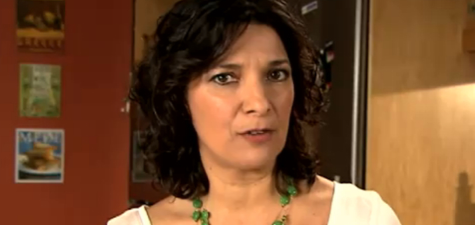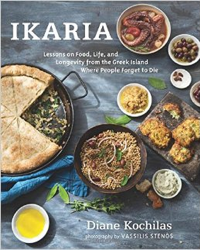
If you want to live longer, statistically longer than most people, it’s a good idea to start by studying a place where people do just that: Ikaria, a remote Aegean Island near Samos where prolific cookbook writer Diane Kochilas‘ family hails. Her new book, Ikaria: Lessons on Food, Life and Longevity from the Greek Island Where People Forget to Die (Rodale 2014) unlocks the secrets of this remote Aegean island:
But, of course, she does write about the diet and food on the island. If you are familiar with Michael Mosleys Fast Diet and intermittent fasting, then the Ikarian diet will make a great deal of sense. Eat quality not quantity. Food is scarce so Ikarians do not eat very much, but what they eat is of excellent quality. If you are looking for a new way of approaching food, incorporating a Mediterranean diet that makes sense in terms of health, longevity, and nutrition, then it would be hard to beat the Ikarian diet, and hard to beat Diane’s lovely book.
 Take a look at the first chapter of recipes: Mezedes: Small Bites of Big Hospitality. Diane writes:
Take a look at the first chapter of recipes: Mezedes: Small Bites of Big Hospitality. Diane writes:
To understand the idea of shared food¬–small bites or mezedes–on Ikaria is to understand the sense of community, camaraderie, and generosity that permeates just about every aspect of life on the island. (p. 2)
It is not only that Ikarians eat well and wisely, but that it is a social occasion of sharing hospitality. Incorporating that kind of hospitality and communal eating– so often missing in American lives – is as important as improving what we eat. Rather than eat chips, Ikarians eat whipped or beaten cheese, or Kopanisti. Diane includes two recipes for Kopanisti, Mary Sofos’ Ikarian-style New York Kopanisti (p. 6) that includes feta, Roquefort, ricotta and spices, and Whipped Feta Kopanisti (p. 7) that includes goat’s milk feta, Greek oregano and olive oil.
Ikarians do eat fried food like many other areas of Greece and the Mediterranean as a whole. Nikos Politis‘ Zucchini Sticks (p. 13) are fried in olive oil. Diane cautions that it’s best made with very local, fresh zucchini that are similar to the zucchini used in Ikaria – only in season and picked fresh. There is also a recipe for Fried and or Stuffed Zucchini Flowers (pp. 14-15) with Manouri and feta cheeses, mint, and lemon. But if you are shying away from frying, try Fried or Baked Zucchini Fritters with Oregano or Mint (p. 18). A photo by Vassillis Stenos shows chubby, golden brown cakes in a pan. Another page shows small Potato-Cheese Croquettes (pp.24-5) flavored with mint, parsley, and nutmeg. There are essays throughout the book on Drying Summer’s Bounty for the Winter (pp. 16-7), Ikaria’s Potent Wine (p. 23) and Mushrooming in the Mountains (pp. 27-9) which will put Ikaria on top of your places to visit.
Beyond mezedes, Ikarians eat salads, soups, vegetables as a main course, grains and even meat, and fish. Diane even includes a chapter on Iconic sweets, most featuring the amazing honeys collected on the island (pp. 280-3). There is, however, one recipe with petimezi or for those more familiar with Turkish cuisine, pekmez or grape molasses. She uses it in Grape Molasses Chocolate Cake (p. 294-5) that turns out to be a very unusual, very good cake.
This isn’t just another Greek cookbook. It is a thoughtful, loving look at how people on a small rocky island live long and live well. Ikaria would make a excellent gift for anyone who made a New Year’s resolution to eat well and stay healthy.
Makes 6 to 8 cake servings or 12 cupcakes
1 cup water
1 cinnamon stick
5 whole cloves
1 cup Greek extra virgin olive oil
6 tablespoons brown sugar
1 ½ cups petimezi (grape molasses)
Grated peel and juice of 1 large orange
¼ cup Greek tsipoura, ouzo, or grappa
1 teaspoon baking soda
5 to 6 cups all-purpose flour
1 cup dark chocolate chips
2 tablespoons granulated sugar
½ cup sesame seeds
Preheat oven to 350 degrees F. Lightly oil a 12-inch springform pan or 12 cups of a muffin tin.
In a small pot, combine the water, cinnamon stick, and cloves and bring to a boil over medium heat. Turn off the heat and let the spices seep for 15 minutes. Strain.
In a stand mixer fitted with a whisk attachment, whip the olive oil and brown sugar together until fluffy. Add the spice water, petimezi, orange peel and tsipouro or ouzo or grappa. Mix well.
Dissolve the baking soda in the orange juice and stir into the petimezi mixture.
Sift 5 cups of the flour into a medium bowl.
Gently whisk the flour into the petimezi mixture. If the batter is loose, add a little more flour. Stir in the chocolate chips, if using.
Scape the batter into the springform or muffin cups. Toss the granulate sugar and sesame seeds together and sprinkle over the cake. Bake until a toothpick inserted in the center comes out clean. 50 minutes for the cake, 40 to 45 minutes for the cupcakes.
Serve the cake as is, or with a bit of petimezi or chocolate syrup drizzled over or around it. Serve the cupcakes, if making, the same way. Petimezopita is delicious with vanilla ice cream, too.

1 comments on “Diane Kochilas: Ikaria”